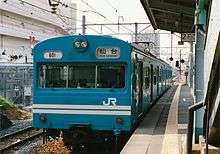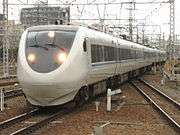105 series
| 105 series | |
|---|---|
|
Set K09 on a Kabe Line service in May 2012 | |
| In service | 1981–Present |
| Number built | 125 vehicles |
| Number in service | 112 vehicles (56 sets) |
| Formation | 2/4 cars per trainset |
| Operator(s) |
JNR (1981-1987) JR East (1987-1998) JR-West (1987-Present) |
| Depot(s) | Hineno, Okayama, Shimonoseki, Hiroshima |
| Line(s) served |
Sakurai Line Wakayama Line Kisei Main Line Sanyō Main Line Fukuen Line Ube Line Onoda Line |
| Specifications | |
| Car body construction | Steel |
| Car length | 20,000 mm (65 ft 7 in) |
| Width | 2,800 mm (9 ft 2 in) |
| Doors | 3/4 pairs per side |
| Maximum speed | 100 km/h (60 mph) |
| Traction system | Resistor control |
| Power output | 440 kW per car with motors |
| Electric system(s) | 1,500 V DC |
| Current collection method | Overhead catenary |
| Braking system(s) | Dynamic brake, Electro-pneumatic brake, Hand brake |
| Track gauge | 1,067 mm (3 ft 6 in) |
The 105 series (105系 Hyaku-go-kei) is a DC electric multiple unit (EMU) train type formerly operated by Japanese National Railways (JNR), and currently operated on local services by West Japan Railway Company (JR-West) in Japan since 1981. They were also formerly operated by East Japan Railway Company (JR East).[1]
Overview
The 105 series was introduced in 1981 to replace early EMU types operating on the Fukuen Line, Ube Line, and Onoda Line in western Japan. The rural nature and low line speed of these lines meant that 101 series or 103 series commuter EMUs would have been unnecessarily over-powered with their high proportion of motored cars, and so the 105 series was designed with one motored car per two cars.[2]
The first sets introduced were 105-0 series 2-car sets which were newly built in 1981 with three pairs of doors per side.[1] 105-500 series 2-car sets were later introduced, converted from former 103 series EMU cars, with four pairs of doors per side.[1]
As of 1 April 2012, 56 2-car sets are operated by JR-West, based at Hineno, Okayama, Shimonoseki, and Hiroshima depots.[3]
105-0 series
60 105-0 series vehicles were built in 1981, formed as 2-car sets for use on the Onoda Line and Ube Line, and 4-car sets for use on the Fukuen Line.[4] Initially, these sets were not equipped with air-conditioning.[2]
Formations
These were originally formed as follows.[2]
4-car sets
| KuMoHa 105 | SaHa 105 | MoHa 105 | KuHa 104 |
The KuMoHa and MoHa cars were each equipped with one lozenge-type pantograph.
2-car sets
| KuMoHa 105 | KuHa 104 |
The KuMoHa cars are equipped with one lozenge-type pantograph.
Interior
Seating accommodation consists of longitudinal bench seating throughout each car.[2]
-
A non-air-conditioned 105-0 series set in Fukuen Line livery in 1987
105-500/600 series
The 105-500/600 series variant was introduced from October 1984, coinciding with the electrification of the Nara Line between Kyoto and Nara, and the Wakayama Line between Wakayama and Gojō.[5] Budget restraints prevented the construction of new trains, and instead, former Jōban Line 103-1000 series EMU cars made surplus by the introduction of 203 series EMUs were modified with the addition of new cab ends to form 2-car 105-500 series sets.[5]
Senseki Line sets

In March 1987, four former 103 series air-conditioned driving cars were converted to become 2-car 105 series sets for use on the Senseki Line in the Sendai area. These sets retained the original non-gangwayed 103 series cab ends.[6]
References
| Wikimedia Commons has media related to 105 series. |
- 1 2 3 JR全車輌ハンドブック2009 [JR Rolling Stock Handbook 2009]. Japan: Neko Publishing. 2009. pp. 352–353. ISBN 978-4-7770-0836-0.
- 1 2 3 4 Fukuhara, Shunichi (May 2012). 105系通勤形電車のあゆみ その1 [History of the 105 series commuter EMU - Part 1]. Japan Railfan Magazine. Japan: Koyusha Co., Ltd. 52 (613): 108–111.
- ↑ JR電車編成表 2012夏 [JR EMU Formations - Summer 2012]. Japan: JRR. May 2012. p. 408. ISBN 978-4-330-28612-9.
- ↑ Fukuhara, Shunichi (June 2012). 105系通勤形電車のあゆみ その2 [History of the 105 series commuter EMU - Part 2]. Japan Railfan Magazine. Japan: Koyusha Co., Ltd. 52 (614): 120–123.
- 1 2 Fukuhara, Shunichi (August 2012). 105系通勤形電車のあゆみ その3 [History of the 105 series commuter EMU - Part 3]. Japan Railfan Magazine. Japan: Kōyūsha Co., Ltd. 52 (616): 96–101.
- ↑ JR全車輛ハンドブック'92 [JR Rolling Stock Handbook 1992]. Japan: Neko Publishing. 1992. p. 242.


